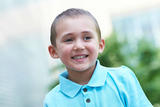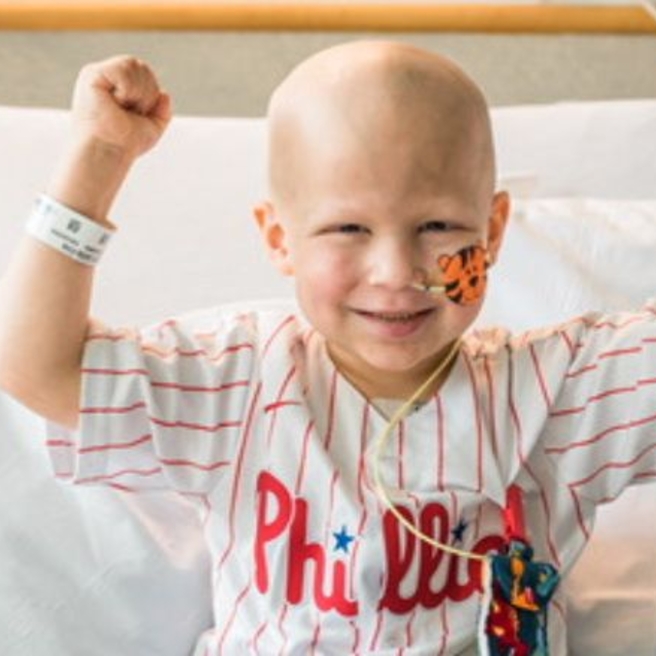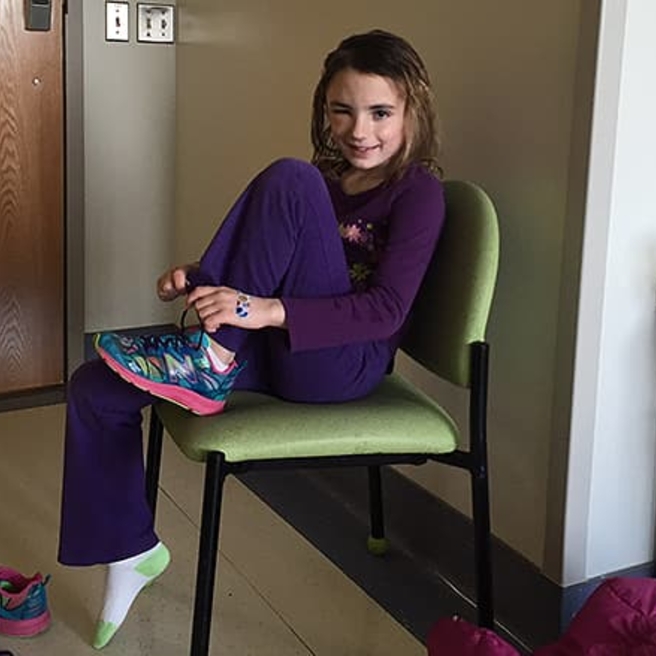What are brain tumors?
A brain tumor occurs when there is a genetic alteration in the normal cells in the brain. The alteration causes the cells to undergo a series of changes that result in a growing mass of abnormal cells. Primary brain tumors involve a growth that starts in the brain, rather than spreading to the brain from another part of the body.
Brain tumors may be low grade (less aggressive) or high grade (very aggressive). The cause of primary brain tumors is unknown, although some tumors have germ line mutations and tend to be hereditary. The majority result from somatic mutations and are not hereditary.
Central nervous system tumors (tumors of the brain and spine) are the most common solid tumor in children. There are approximately 4,500 new brain tumors each year, and they are the most common cause of cancer deaths.
Tumor types
The majority of pediatric tumors are in the posterior fossa (60 percent). The most common tumors, in decreasing frequency, are: Medulloblastoma, juvenile pilocytic astrocytoma (JPA), ependymoma, diffuse intrinsic pontine glioma (DIPG), and atypical teratoid rhabdoid tumor (ATRT).
The other 40 percent of pediatric brain tumors are in the cerebral hemispheres of the brain. These include astrocytomas, gangliogliomas, craniopharyngiomas, supratentorial primitive neuroectodermal tumors (PNET), germ cell tumors, dysembryoplastic neuroepithelial tumors (DNET), oligodendrogliomas, and meningiomas
Gliomas
The most common type of brain tumor at all ages is a glioma. Gliomas consist of glial cells, which form the supportive tissue of the brain. The two major types of glial tumors are astrocytomas and ependymomas.
- Astrocytoma. Astrocytomas are the most common type of childhood glioma and favor the nervous system. They typically occur in the cerebellum, a part of the brain that coordinates voluntary muscle movements and maintains posture, balance and equilibrium. The majority are curable by surgery. Astrocytomas may arise in the optic nerve, especially in children with neurofibromatosis. Children may also suffer from gliomas in the brainstem, at the base of the brain.
- Malignant Gliomas. These tumors, including the anaplastic astrocytomas and glioblastomas, can develop anywhere in the brain and are much more aggressive than astrocytomas. They are never cured by surgery alone and require combination therapy with radiation and chemotherapy.
- Ependymoma. This type of glial tumor usually arises from the cells lining the ventricles — the cerebrospinal fluid-filled cavities in the brain. Often slow growing, glial tumors may reoccur after treatment.
Mixed neuronal-glial tumors
Tumors containing a mix of glial cells (most commonly astrocytes) and neurons (ganglion cells) occur more often in children than in adults. They may develop anywhere in the nervous system but most typically appear in the cerebrum, an area of the brain involved in motor function and personality. Surgery to remove mixed neuronal-glial tumors often is effective.
- Ganglioglioma. This is the most common of the mixed neuronal-glial tumors and generally appears in childhood or the early teen years. The majority are benign and can usually be treated successfully by surgery.
- Subependymal giant cell tumor. These tumors are common in children who have a genetic condition called tuberous sclerosis. These tumors are rarely malignant.
- Pleomorphic xanthoastrocytoma. These tumors are most commonly seen in teens or young adults; most are benign.
Embryonal tumors
Up to 25 percent of nervous system tumors that occur in infants and children are tumors made up of poorly-differentiated neuroepithelia cells. When the nervous system develops, neuroepithelia cells are those that differentiate into glial (supportive tissue) and nerve cells.
The two main types of embryonal tumors are:
- Primitive neuroectodermal tumor (PNET). This most common embryonal tumor can arise anywhere in the nervous system but typically appears in the cerebellum. When this happens, it is called medulloblastoma. New advances in therapy have made treatment more effective for these tumors.
- Atypical teratoid/rhabdoid tumor. Ninety percent of patients with these tumors are age 2 or younger. Approximately 90 percent of these tumors have a chromosomal abnormality involving chromosome 22. The tumors may arise anywhere in the nervous system but typically appear in the cerebellum. They may also appear in the kidneys of infants. At the time of diagnosis, about one-third of these tumors have spread throughout the nervous system.
Choroid plexus papilloma/carcinoma
These tumors may also be found in ventricles. They may be benign or malignant, and may spread throughout the nervous system. Choroid plexus papillomas/carcinomas are filled with blood vessels (vascular), making them difficult to remove because of their tendency to bleed.
Tumors arising from non-neuroepithelial tissue
The intracranial (inside the skull) and intraspinal (within the spine) cavities contain tissues and structures that may give rise to tumors, a number of which are more common in children than adults. These tumors include:
- Craniopharyngioma. These benign tumors are thought to originate from residual tissue left behind following the development of the head. Because they occur at the front base of the brain near the pituitary gland and optic nerves, they may cause serious neurological and endocrine problems. Surgery may not be able to completely remove them.
- Pineal region tumors. These tumors can arise near the pineal gland at the base of the skull. The most common type, germinoma, is treated with radiation.
Meningeal tumors
The brain and spinal cord are covered with membranes called dura mater, arachnoid, and pia mater. Tumors called meningiomas may develop in these membranes, but are more common in adults than children.
Signs and symptoms
The symptoms of a pediatric brain tumor vary according to the size, type, and location of the tumor. Symptoms may occur when a tumor presses on a nerve or damages certain parts of the brain. They may also occur when the brain swells or there is fluid buildup in the skull. The most common symptoms include:
- Headaches (usually worse in the morning)
- Nausea or vomiting
- Changes in speech, vision or hearing
- Problems balancing or walking
- Changes in mood, personality or ability to concentrate
- Problems with memory
- Muscle jerking or twitching (seizures or convulsions)
- Numbness or tingling in the arms or legs
Diagnosis
After taking a complete medical history and doing a physical examination of your child, we may use the following diagnostic tests to determine if a brain tumor is present:
- Neurological exam. Your child's physician will test reflexes, muscle strength, eye and mouth movement, coordination and alertness.
- Computerized tomography scan (CAT scan or CT scan). This imaging procedure uses a combination of X-rays and computer technology to produce cross-sectional images (called 'slices') — both horizontal and vertical — of the bones, muscles, fat and organs.
- Magnetic resonance imaging (MRI). This imaging procedure uses a combination of large magnets, radiofrequencies and a computer to produce detailed images of organs and structures within the body.
- X-ray. This imaging test uses invisible electromagnetic energy beams to produce images of internal tissues, bones and organs onto film.
- Bone scan. This imaging test takes X-rays of the bones after a dye has been injected that is absorbed by bone tissue.
- Angiogram. This imaging test uses a dye to visualize all the blood vessels in the brain to detect certain types of tumors.
- Lumbar puncture/spinal tap. For this procedure, a special needle is placed into the lower back and into the spinal canal around the spinal cord. A small amount of cerebrospinal fluid, which surrounds the brain and spinal cord, can be removed and sent for testing.
Treatment
Surgery for pediatric brain tumors
Surgery is usually the first step in treating brain tumors in children. Our goal within the Pediatric Surgical Oncology Program is to remove all or as much of the tumor as possible while maintaining neurological function.
Pediatric brain tumor patients have a particular advantage when coming to CHOP because of the extensive experience of our neurosurgeons and the close collaboration between neurosurgery, neuro-oncology, radiation oncology and diagnostic radiology.
Certain types of brain tumors located near the bottom of the skull, also called skull-base tumors, can be removed through the nose using tools called endoscopes. Because the base of the skull is close to the nostrils and roof of the mouth, your child’s surgeon can access the tumor more easily and safely with endoscopic endonasal surgery by going through the nostrils, minimizing the need for more invasive procedures.
Surgery is also performed for a biopsy — a sample of tissue taken to examine the types of cells found in the tumor. This helps establish a diagnosis and treatment plan. This is frequently done when the tumor is surrounded by sensitive structures that may be damaged by surgical removal.
At Children's Hospital of Philadelphia, every patient being treated for a brain tumor is offered the opportunity to have their tumor entered into a CHOP-led international tumor bank to help accelerate discovery and improve care.
Other therapies used to treat brain tumors include:
- Chemotherapy (cancer drugs)
- Radiation therapy (high-energy rays that kill or shrink cancer cells)
- Proton therapy (a precise form of radiation therapy that is less damaging to surrounding tissue)
- Steroids to treat and prevent swelling in the brain
- High-dose chemotherapy, stem-cell rescue, and blood and marrow transplantation
- Supportive care for the side effects of the tumor or treatment
- Rehabilitation to regain lost motor skills and muscle strength
- Continuous follow-up care to manage disease, detect recurrence of the tumor and manage late effects of treatment

Get a Second Opinion from CHOP
Our experts are here to review your child's diagnosis and treatment plan, and work with primary oncologists as needed
Outlook
As with any cancer, prognosis and long-term survival vary greatly from child to child. Prompt medical attention and aggressive therapy are important for the best prognosis. Continuous follow-up care is essential for a child diagnosed with a brain tumor, because the side effects of radiation and chemotherapy — as well as second malignancies — can occur in survivors of brain tumors.
Rehabilitation for lost motor skills and muscle strength may be required. Children's Hospital speech, physical and occupational therapists specialize in the unique needs of children undergoing this type of rehabilitation.
Late effects/cancer survivorship
Some children treated for a pediatric brain tumor may develop complications years later. Our Cancer Survivorship Program provides information about the potential long-term effects of the specific treatment your child received, including ways of monitoring and treating these effects.
Resources to help
Pediatric Brain Tumors Resources
Pediatric Neuro-Oncology Program Resources
Find everything you need to support your child’s health and your family’s well-being.
Reviewed by Phillip B. Storm, MD


